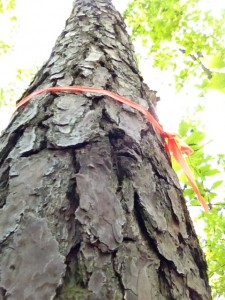 The Lake Champlain Land Trust was lucky to partner with Dr. Phillip Howard to accept a conservation agreement on his 78-acre property in Colchester, VT. As Dr. Howard recognized decades ago, over 35 acres of the property includes a rare Sandplain Forest.
The Lake Champlain Land Trust was lucky to partner with Dr. Phillip Howard to accept a conservation agreement on his 78-acre property in Colchester, VT. As Dr. Howard recognized decades ago, over 35 acres of the property includes a rare Sandplain Forest.
The Sandplain Forest type is the rarest wildlife habitat type in Vermont. Over 23 rare plants depend on the unique open canopy and sandy soils to survive. The Sandplain Forest is naturally a open woodland canopy dominated by the evergreen Pitch Pine.
Unfortunately for the Pitch Pine, large Oak and White Pine trees have taken over the canopy. This is blocking out the light young Pitch Pines need to grow. It is also covering the forest floor with leaf litter, preventing new Pitch Pine seeds from germinating.
Sandplain Forests are typically a Pine-Oak-Heath mix, however without natural disturbances (such as lightning fires) the Oak trees are over-crowding the Pitch Pine trees.
In order to help protect the largest conserved Sandplain Forest in Vermont, we are trying a few strategies to restore our conserved Sandplain Forest including working for a strong Pitch Pine population.
- Removing large Oak and White Pine trees in areas where Pitch Pines are holding on.
- Raking areas of future canopy cuts to allow for new Pitch Pine trees to germinate.
Most of the remaining patches of Sandplain Forests in the eastern United States are surrounded closely by residential developments. So we are not only restoring this patch without the use of prescribed burns, we have set up a long-term research plot to track and share our work.
If you want to learn more about our project or would like to volunteer to help out, contact our Restoration Coordinator at .

